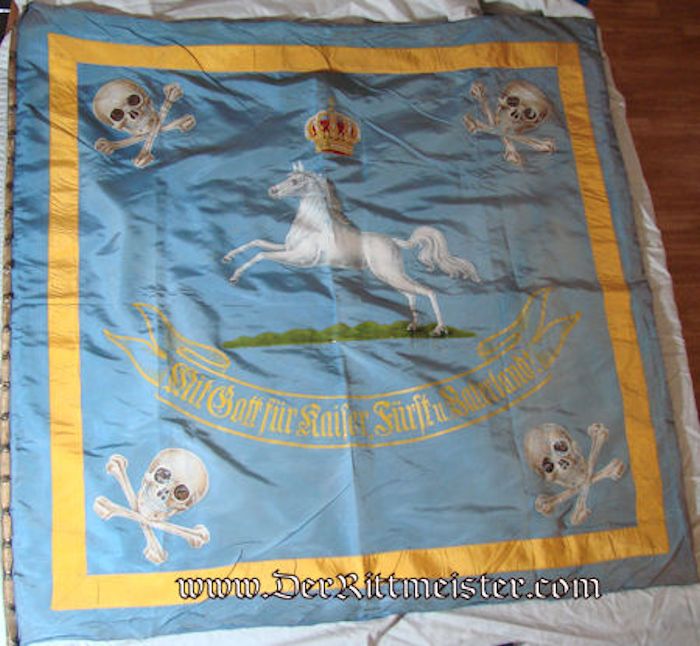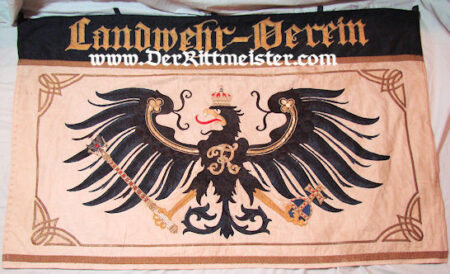Description
Over the years we have offered many special items from the Duchy of Braunschweig, one of our favorite German states. Part of this Duchy’s and its army’s allure arises from Husaren-Regiment Nr 17’s and Infanterie-Regiment Nr 92’s Totenköpfe (Death’s Heads), which were displayed on their headdress and acted as their persona. To that end, today we are offering you one of the most important items ever, a veterans’ flag for both regiments. It is more than a mere veterans’ flag, however, much more. Allow me to share a regimental banner’s importance with you, as this particular banner shares some great similarities. A regimental banner was any regiment’s most important possession. This goes back to early European times, when European nations’ armies received their regimental flags/banners from their nations’ monarchs. It was personally entrusted to them by their sovereign as his representatives. To lose your regimental flag/banner in battle was a matter of grave consequence. Every man, from the lowliest private all the way up to the regiment’s commander, was shamed by its loss. Such a loss generally signaled the end of a regimental commander’s military career, and turned him into a social pariah. Regiments fought hard for their country’s honor to begin with, and fought doubly hard to protect their flags from the enemy during battle. In the English Army, for example, senior sergeants were assigned to protect the flag with special weapons. Like all regiment members, these men fought to the death to protect their regimental colors. It was no less important in the German Army. The German Army followed a special process when awarding a regiment its colors. The King (or Kaiser) gathered the regiment and personally consecrated the regiment’s colors to it. This was a solemn ceremony. The colors were given over to the regiment with great pomp and circumstance. Flag rings or special streamers that commemorated the consecration of the regiment’s colors for their honorable use in representing their King (or Grand Duke, Duke, or Prince, etc.) were included. This occasioned a major gathering of the regiment’s men as their ruler awarded them their colors as his honorable representatives in public gatherings, AND in battle, if necessary. This use of battle colors pretty much ended with either the 1870-1871 Franco-Prussian War or WW I’s VERY earliest days. [It became clear early in WW I that warfare as it once had been practiced was changed forever with the advent of machine guns, rapid firing cannons, poison gas, airplanes, trenches, and tanks. Cavalry charges were at an end (cavalry fought the WW I’s majority as dismounted units). war was changed]. Prior to WW I’s advent, however, regimental flags were still significant, and the manner in which they were conveyed was a matter of great importance. The following bit of history emphasizes their significance. In 1866, the Austro-Prussian War was the final piece of the puzzle that concluded Germany’s consolidation, which had begun under Prussia’s König Friedrich Wilhelm IV in the 1840’s. His brother, König Wilhelm I, had succeeded him in 1861, and had led Prussia in the smashing defeat of Austria and her German allies (including the Kingdoms of Saxony, Bavaria, Württemberg, and Hannover). The three kingdoms suffered little change, but Prussia annexed Hannover, absorbing its territory AND military. Hannover’s King, who had strong ties to Great Britain, lost control of his kingdom. Hannover’s vassal state, the Duchy of Braunschweig, also was annexed. In 1885, Prussia’s Prinz Albrecht (1837-1906) was appointed Regent over Braunschweig by his uncle, Kaiser Wilhelm I. Albrecht had entered the Prussian army in 1847. He had served in both the 1866 Austro-Prussian War and the 1870-1871 Franco-Prussian War, commanding a Garde-Kavallerie Brigade in that war. He rose to command the X. Armeekorps in 1874, which was headquartered in the Kingdom of Hannover’s former capital city, Hannover. Thus, he was positioned for the appointment as Regent of Braunschweig when that took place in 1885. He actually moved to Braunschweig when his appointment took place in order to administer the former Duchy. [It is interesting to note that he was promoted to generalfeldmarschall shortly after Kaiser Friedrich III’s death in June 1888, during the first few days of Kaiser Wilhelm II’s rule]. Prinz Albrecht continued to administer Braunschweig until his death in 1906. [Please keep the year 1906 in mind, as it becomes more important later in our description].
* The Banner. This magnificent and historically significant banner measures 3’ 8″ x 3’ 6 1/2.” The banner is made of high-grade silk. The banner contains a substantial weight and heft. Its printing is double-sided. Although one side is crisper and better- defined than the other, I cannot tell if an actual difference existed when it was manufactured, or if it is a matter of fading and age. The banner’s background is light-blue. A yellow frame within the blue background houses all that I am about to describe. The blue background and yellow frame together represent Braunschweig’s state colors. These same colors are seen in their decorations’ ribbons and on their headdresses’ kokarden. Each corner sports a Braunschweig-style Totenkopf. They are quite large and impressive, measuring 7″ x 7 3/4.” They are identical to the Totenköpfe appearing on the regiments’ pickelhauben, busbies, mützen, and schirmützen. In the banner’s center is the Kingdom of Hannover’s and the Duchy of Braunschweig’s white horse, in profile. Above the horse we see the crown that formed part of the two states’ Coats-of-Arms. Below the crowned horse is a bandeau outlined in yellow. Within the bandeau we see “Mitt Gott Für Kaiser, Fürst, and Vaterland.” The banner’s left side displays a series of decorative nails whereby the banner was attached to its flagpole.
*The Flagpole. Over the years that we have offered various flags and banners, we have only offered one that had a partial pole. That is part of what makes today’s offering so special — it COMES with its original pole (and a very special pole at that)! The banner and pole come from a very fine European source. In order to get the pole here, it could not be shipped intact. We consulted several shipping sources. In every case ,due to the pole’s length, the carriers would NOT ship it. Reluctantly, we removed the flag, then separated the pole. It is now in two pieces. The two pieces measure 4’ 1 1/2″ and 4’ 3 1/2,” respectively. The pole is white. Due to its age, some of its white finish is missing in places. The bottom half has a rounded base. The top half has a brass attachment, which has a female screw attachment that allows a flag topper to be screwed into it. The flag topper is not present. The flagpole’s lower half sports a brass rectangular plate that says “Landwehr-Verein Wedtleenstedt.” During the post WW I Period large veterans’ reunions were often held all over Germany wherein veterans met with former comrades. While not exactly like the USA’s American Legion or the Veterans of Foreign Wars, it allowed veterans to share their military and personal experiences. It was healthy for these veterans to share those experiences with others who understood the war’s true nature. Often at these congregations, badges were issued for attending the gathering. Flagpoles could be adorned with the badges, which were rounded to fit a circular flagpole. The flagpole’s upper half has two of these badges. The first device measures 2 3/4″ x 2.” At its top is a likeness of von Hindenburg. Below his likeness we see the following,
“25
Landwehr-
Verein
Timmerlah
15.7.28″
The second plaque measures 2 3/4″ x 2 1/2,” and has a 1914 Iron Cross at the top. Below the Iron Cross we see the following:
“Zum 25 Jähr
Stiftungsfest
gew. V.
Landwehr-Verein
Lehndorf
15.7.1928”
This leads me to believe that two different veterans groups attended two different gatherings representing Braunschweig on the same date. They brought back the badges, which were then affixed to their flagpole. It is also noteworthy that these gatherings were held ten years after WW I’s end. [The gatherings were actually held on 15 July 1928, and the war ended on 11 November 1918, so it was just about four months short of the ten-year mark]. I believe this presentation’s final piece ties all of it together, (it even addresses the severed flagpole problem). Earlier I mentioned that the Braunschweig’s Regent held the position until his 1906 death. I also mentioned the formal ceremony’s importance (when a monarch conveyed the regimental colors to a unit). It practically was a consecration, a holy ceremony. A token usually was attached to the flagpole to show that the monarch had indeed conveyed the flag. The token showed that the monarch was accompanying his troops in spirit wherever they ventured, whether during peace or war. In Germany, the monarch’s token was either a streamer or a metal ring that was added the flagpole. Just such a ring accompanies this banner and flagpole! It is bronze-toned in color, although I cannot tell its metal type. It has a burnished finish. It has a crowned cypher “A” on the side, which, of course, stands for Prussia’s Prinz Albrecht, Braunschweig’s Regent. Directly below his cypher is the year “1903,” which was three years before his death. A very practical function the ring serves is to allow the flagpole’s two halves to be joined together. Two holes appear in the ring’s side so it can be screwed into place and join the halves together. Make no mistake, this will NOT allow you to march around carrying the flagpole! It could be used for display purposes only if you propped it in a corner. Although I have offered several states’ regimental veterans’ flags in the past, this one is truly special. This banner and pole were directly bestowed to the group by Braunschweig’s Prinz Regent more than one-hundred-years ago. The banner’s condition is first-rate, showing only minor signs of age. It also represents two of the German Army’s most storied regiments. Both regiments fought with Wellington at Waterloo. One regiment also fought with him during the Peninsula Campaign. Both also served during the 1870-1871 Franco-Prussian War. It will make a superb display in your collector’s area.



